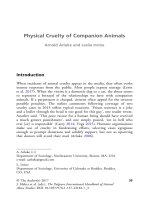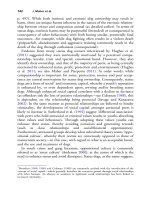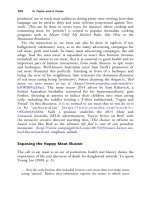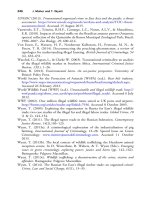The palgrave international handbook of a 101
Bạn đang xem bản rút gọn của tài liệu. Xem và tải ngay bản đầy đủ của tài liệu tại đây (26.56 KB, 1 trang )
Animal Neglect
91
Children may also simply grow out of human-animal companionship as other
priorities dominate. When dietary and mental health needs are not provided
for, such that this constitutes abuse; even where such abuse is accidental, this
neglect can have severe mental and physical consequences for a non-human
companion. Secondly, accidental neglect can be indicative of an anthropogenic notion that non-human animal lives carry less importance than
human lives and indeed of wider negative attitudes towards (all) other
vulnerable members of a family including spouses or children (briefly
discussed later). Thus neglect may be symptomatic of tolerance towards
animal abuse which Nurse (2013) concluded includes inflicting cruelty
either directly or indirectly, or failing to comply with statutory animal
welfare standards such that a non-human animal incurs harm, injury,
suffering or distress, either by human act or omission. Omission is
central to neglect, but arguably whether the omission is deliberate or
accidental is irrelevant; this chapter argues that neglect, in its various
forms, constitutes animal abuse. Actions arising from well-meaning activity but which nevertheless result in neglect are also abuse.
This chapter considers both deliberate and accidental neglect and also
examines how some neglect, in addition to being accidental, may arise from
good intentions. Nathanson (2009, p. 307) and other researchers have also
examined the phenomenon of animal hoarding, ‘a deviant behaviour associated with extremely deleterious conditions of comorbid animal and selfneglect’, where individuals attempt to take care of more animals than is
practical and neglect is the result. While hoarding is covered in more detail
in another chapter within this volume (see chapter on Animal Hoarding
herein), Nurse (2013, pp. 92–93) identifies that the Royal Society for the
Prevention of Cruelty to Animals (RSPCA) the Scottish Society for the
Prevention of Cruelty to Animals (SSPCA) and environmental health
agencies in the UK (and their respective organisations in other countries)
frequently deal with these unlawful neglect cases. The American Society for
the Prevention of Cruelty to Animals (ASPCA) also estimates 900–2,000
new cases of animal hoarding every year in the USA (ASPCA 2015). The
Animal Legal Defense Fund (ALDF) has also identified that over a third of
the thousands of cases on its animal cruelty database are of neglect. It states
neglect as being among the most common animal abuse problems reported
and one of the most significant animal cruelty problems in the USA today
(Otto 2007, p. 4). Reliable UK figures on neglect are unavailable. Hoarding
is, thus, a social problem and, represents neglect through omission where
abuse is caused by a failure to adequately care for companions. The RSPCA
defines a hoarder as somebody who has accumulated a large number of









